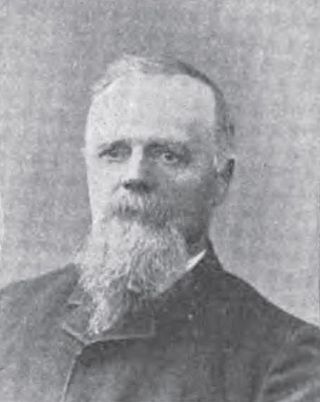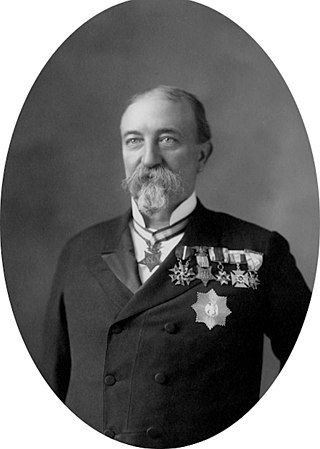
Theophilus Francis Rodenbough was born in Easton, Pennsylvania and was a Union Army officer during the American Civil War. He received America's highest military decoration the Medal of Honor for his actions at the Battle of Trevilian Station. After his retirement from the U.S. Army in 1870, he wrote several books about military history.

Orlando Bolivar Willcox was an American soldier who served as a general in the Union Army during the American Civil War.

Richard Conner was an American Civil War Union Army soldier who received the Medal of Honor for his bravery in action.

Absalom Baird was a career United States Army officer who distinguished himself as a Union Army general in the American Civil War. Baird received the Medal of Honor for his military actions.

Julius H. Stahel-Számwald was a Hungarian soldier who emigrated to the United States and became a Union general in the American Civil War. After the war, he served as a U.S. diplomat, a mining engineer, and a life insurance company executive. He received the Medal of Honor for gallantry in action at the Battle of Piedmont in 1864.
The 30th Ohio Infantry Regiment was an infantry regiment in the Union Army during the American Civil War.
Walter Howard Cooke was a Union Army officer who fought in the American Civil War. Cooke received his country's highest award for bravery during combat, the Medal of Honor, for his actions at the First Battle of Bull Run in Virginia on 21 July 1861. He was honored with the award on 19 May 1887. He undertook several short periods of service in the Army before being discharged in 1863 and returning to civilian life. He then undertook a variety of business roles, including a directorship of a bank in Norristown and charity work. He died in 1909 at the age of 70.

Andrew Henry Embler was an officer in the Union Army during the American Civil War. He received the country's highest award for bravery during combat, the Medal of Honor, for his action during the Battle of Boydton Plank Road in Virginia on October 27, 1864. He would later serve as the Connecticut Adjutant General for two years.
Private David Edwards was an American soldier who fought in the American Civil War. Edwards received the country's highest award for bravery during combat, the Medal of Honor, for his action during the Battle of Five Forks in Virginia on 1 April 1865. He was honored with the award on 10 May 1865.

The 72nd New York Infantry Regiment was one of five infantry regiments formed by former U.S. Congressman Daniel Sickles and established as part of the Excelsior Brigade which fought with the Union Army during multiple key engagements of the American Civil War, including the Chancellorsville Campaign in Virginia, the Battle of Gettysburg in Pennsylvania, and the Overland Campaign. Leaders from the 72nd New York recruited men from New Jersey, as well as from cities and small towns across the State of New York.
Benjamin Gifford was an American soldier who fought in the American Civil War. Gifford received his country's highest award for bravery during combat, the Medal of Honor. Gifford's medal was won for his capturing the flag during the Battle of Sailor's Creek on April 6, 1865. He was honored with the award on May 10, 1865.

Abiather J. Knowles was an American soldier who fought in the American Civil War. Knowles received his country's highest award for bravery during combat, the Medal of Honor. Knowles's medal was won for his actions during the First Battle of Bull Run in Prince William County, Virginia on July 21, 1861. He was honored with the award on December 27, 1894.
Asel Hagerty was an American soldier who fought in the American Civil War. Hagerty received his country's highest award for bravery during combat, the Medal of Honor. Hagerty's medal was won for his capturing a flag at the Battle of Sayler's Creek, Virginia on April 6, 1865. He was honored with the award on May 10, 1865.
George Grueb was an American soldier who fought in the American Civil War. Grueb received his country's highest award for bravery during combat, the Medal of Honor. Grueb's medal was won for his capturing a flag at the Battle of Chaffin's Farm, Virginia on September 29, 1864. He was honored with the award on April 6, 1865.
Joseph Keene was an American soldier who fought in the American Civil War. Keene received his country's highest award for bravery during combat, the Medal of Honor. Keene's medal was won for his actions at the Battle of Fredericksburg in Virginia, where he voluntarily seized his regiments colors after several Color Bearers had been shot down and led his regiment in the charge on December 13, 1862. He was honored with the award on December 2, 1892.

John H. Haight was a United States soldier who fought with the Union Army during the American Civil War as a member of the 72nd New York Infantry. He was recognized with his nation's highest honor for valor, the U.S. Medal of Honor, for the extraordinary heroism he displayed in 1862 during the Battle of Williamsburg, Manassas Station Operations, and Second Battle of Bull Run.

The 13th New York Infantry Regiment was an infantry regiment in the Union Army during the American Civil War.

Henry Edwin Tremain (1840–1910) was an American Civil War Medal of Honor recipient who was on the staff of several generals. He received the Medal of Honor for his actions at the Battle of Resaca, when he voluntarily rode between two brigades of Union soldiers who were mistakenly firing at each other, and stopped the firing.

Charles Franklin Rand was an American Civil War Medal of Honor recipient. He received the award for his actions at the Battle of Blackburn's Ford, Virginia, when he stayed in action when a part of his regiment broke in disorder; he then joined another company and fought with it through the remainder of the engagement. Following the war he earned a medical degree and worked as a physician in Batavia, New York. Rand is buried at Arlington National Cemetery.

Julius Dexter Rhodes was a sergeant major in the United States Army who was awarded the Medal of Honor for gallantry during the American Civil War. After having his horse shot from under him at the Battle of Throughfare Gap, he helped the 105th New York Volunteers advance on the enemy line. He was later wounded while fighting in the Second Battle of Bull Run. He was awarded the Medal of Honor on 9 March 1887.












